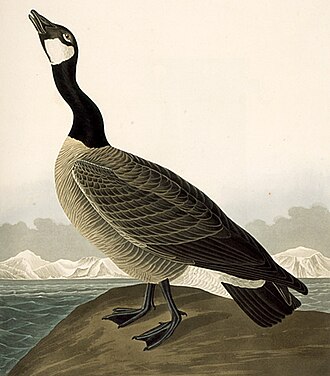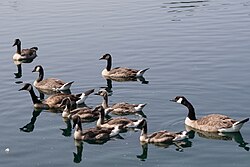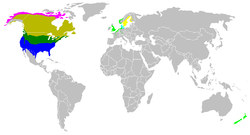Field Guide/Birds/Branta canadensis
- For the Canadian outerwear manufacturer Canada Goose see Canada Goose (clothing)
The Canada Goose (Branta canadensis) belongs to the Branta genus of geese, which contains species with largely black plumage, distinguishing them from the grey Anser species.
The species name, canadensis, is a New Latin word meaning "of Canada".
Appearance
The black head and neck with white "chinstrap" distinguish this goose from all except the Barnacle Goose, but the latter has a black breast and grey, rather than brownish, body plumage. There are seven subspecies of this bird, of varying sizes and plumage details, but all are recognizable as Canada Geese. Some are hard to distinguish from the Cackling Goose (Branta hutchinsii), with which the Canada Goose was long assumed to form one species, and the name Lesser Canada Goose is, confusingly, often applied to B. hutchinsii.
This species is 90-100 cm long with a 160-175 cm wing span. Males weigh 3.5–6.5 kg, (8–14 pounds ), and can be very aggressive in defending territory. The female looks virtually identical but is slightly lighter at 3–5.5 kg (7–12 pounds), and has a different honk.
Behaviour and habitat
These birds feed mainly on plant material. When feeding in water, they submerge their heads and necks to reach aquatic plants, sometimes tipping forward like a dabbling duck. Flocks of these birds often feed on leftover cultivated grains in fields, especially during migration or in winter.
During the second year of their lives, Canada Geese find themselves a mate. Most couples stay together all of their lives. If one is killed, the other may find a new mate, and divorce also occurs, though rarely.& The female lays 4-8 eggs and both parents protect the nest while the eggs incubate, but the female spends more time at the nest than the male. During that time, they lose their flight feathers, so that they cannot fly until after their eggs hatch. This period lasts for 25-28 days.
In some populations, up to 100% of the pairs are homosexual. Both males and females may form same-sex pairs. One study has observed that 18% of the males formed same-sex pair bonds, while for females the ratios varied between 6 and 12%. Courtship behavior is associated with such couples, though copulation is not a prominent feature of same-sex pairs.&
Adult geese are often seen leading their goslings in a line with one parent at the front, and the other at the back of the "parade". While protecting their young, parents often violently chase away nearby creatures, from small blackbirds to other geese, to humans that approach. However, geese may form groups of a number of goslings and a few adults, called crèches. The young do not leave their parents until after the spring migration, when they return to their birthplace.
This well-known species is native to North America. It breeds in Canada and the northern USA in a variety of habitats. However, the nest is usually located in an elevated area near water, sometimes on a beaver lodge. The eggs are laid in a shallow depression lined with plant material and down. The Great Lakes region maintains a very large population of Canada Geese.
Like most geese, it is naturally migratory, the wintering range being most of the USA. The calls overhead from large groups of Canada Geese flying in V-shaped formation signal the transitions into spring and autumn. In some areas, migration routes have changed due to changes in habitat and food sources. In mild climates, such as the Pacific Northwest, due to a lack of former predators, some of the population has become non-migratory.
Some migratory populations in temperate climates frequent cities as well, due to convenient, predator-free open spaces. These birds are considered by many to be a nuisance, mainly because of the large volume of feces they produce, and like other water fowl, they also frequently walk with their young across roads, creating traffic tie-ups. Some cities have begun extermination programs against them. Other solutions have included relocation and the use of a substance to coat the eggs to prevent maturation and hatching. Many geese are also killed in collisions with automobiles and, occasionally, aircraft..
If a goose feels threatend by another creature it will usually warn the creature by giving off a hissing sound.
Other locations
Canada Geese have reached western Europe naturally, as has been proved by ringing recoveries. The birds are of at least the subspecies parvipes, and possibly others. Canada Geese are also found naturally on the Kamchatka Peninsula in eastern Siberia, eastern China, and throughout Japan.

Greater Canada Geese have also been widely introduced in Europe, and have established feral populations in Great Britain, The Netherlands, and Scandinavia. Semi-tame feral birds are common in parks, and have become a pest in some areas. It is now proven that most Scandinavian and some British birds have established a migration pattern. The geese were first introduced in the United Kingdom as an addition to King James II's waterfowl collection in St. James's Park. Finally, Canada Geese were introduced as a game bird into New Zealand, but they have also become a problem in some areas there.
By the early 20th century, over-hunting and loss of habitat in the late 1800s and early 1900s had resulted in a serious decline in the numbers of this bird in its native range. The Giant Canada Goose subspecies was believed to be extinct in the 1950s until, in 1962, a small flock was discovered wintering in Rochester, Minnesota by Harold Hanson of the Illinois Natural History Survey. With improved game laws and habitat recreation and preservation programs, their populations have recovered in most of their range, although some local populations, especially of the subspecies occidentalis, may still be declining. They have adapted well to urban environments, especially those with well-trimmed lawns and large ponds, such as golf courses and city parks.
Taxonomy
The Cackling Goose was originally considered to be the same species or a subspecies of the Canada Goose, but in July 2004 the American Ornithologists' Union's Committee on Classification and Nomenclature split the two into two species, making Cackling Goose into a full species with the scientific name Branta hutchinsii. The British Ornithologists Union followed suit in June 2005.
The AOU has divided the many associated subspecies of both animals:
- Canada Goose (also known as Greater Canada Goose)
- Atlantic Canada Goose (Branta canadensis canadensis)
- Interior Canada Goose (Branta canadensis interior)
- Giant Canada Goose (Branta canadensis maxima)
- Moffit's Canada Goose (Branta canadensis moffitti)
- Vancouver Canada Goose (Branta canadensis fulva)
- Dusky Canada Goose (Branta canadensis occidentalis)
- part of "Lesser complex" (Branta canadensis parvipes)
- Cackling Goose (also known as Lesser Canada Goose or Small Canada Goose)
- Richardson's Cackling Goose (Branta hutchinsii hutchinsii)
- Bering Cackling Goose (Branta hutchinsii asiatica) Template:StatusExtinct
- Aleutian Cackling Goose (Branta hutchinsii leucopareia)
- Small Cackling Goose (Branta hutchinsii minima)
- part of "Lesser complex" (Branta hutchinsii taverneri)
The distinctions between the two geese have led to a great deal of confusion and debate among ornithologists. This has been aggravated by the overlap between the small types of Canada Goose and larger types of Cackling Goose. The old "Lesser Canada Goose" was believed to be a partly hybrid population, with the birds named taverneri considered a mixture of minima, occidentalis and parvipes. In addition, it has been determined that the Barnacle Goose is a derivative of the Cackling Goose lineage, whereas the Hawaiian Goose is an insular representative of the Canada Goose.
See also
- The Canada Goose was depicted on the 1986 series Canadian $100 note.
- The 1996 movie Fly Away Home was about a young girl who finds and raises a brood of orphaned Canada Goslings and attempts to get them to migrate after the birds reach adulthood.
- A Canada Goose was used as the logo for the tail section of Canadian Airlines last livery before the airline merged with Air Canada.
Notes
References
External links
- ARKive - images and movies of the Canada goose (Branta canadensis)
- Stackhouse, Mark. "The New Goose." [1]
- Angus, Wilson. "Identification and range of subspecies within the Canada and Cackling Goose Complex (Branta canadensis & B. hutchinsii)." [2]
- Moser, Timothy J., Craven, Scott R. and Miller, Brian K. "Canada Geese in the Mississippi Flyway: A Guide for Goose Hunters and Goose Watchers" [3]
- RSPB A to Z of UK Birds
Gallery
- RW IMG 3295.JPG
Spring Goslings, Thames Ditton, UK
- CanadaGoslingRotherhithe.jpg
Adult and gosling
- Gos.jpg
- Pbalson 20060527 IMG 3675.JPG
bg:Канадска гъска cy:Gŵydd Canada da:Canadagås de:Kanadagans eo:Kanada ansero fr:Bernache du Canada ik:Iqsrabutilik lt:Kanadinė berniklė hu:Kanadai lúd nl:Grote Canadese gans ja:カナダガン no:Kanadagås pl:Bernikla kanadyjskapt:Ganso-do-canadá sl:Kanadska gos fi:Kanadanhanhi sv:Kanadagås tr:Kanada kazı zh:加拿大雁









